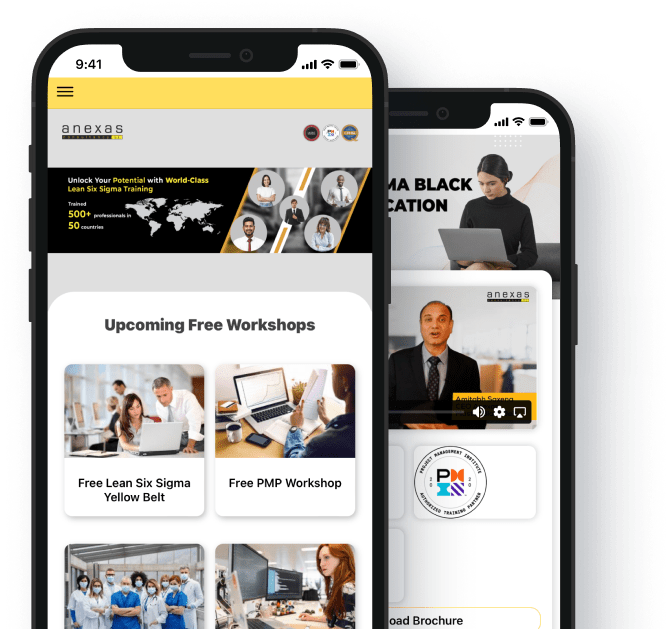Table of Contents
Share This Article
Challenges in Implementing Lean Six Sigma: Common Pitfalls and How to Avoid Them
- 27916 views
Introduction to Challenges in Implementing Lean Six Sigma
Brief overview of Lean Six Sigma
Lean Six Sigma is a management methodology that combines the principles of Lean manufacturing and Six Sigma to eliminate waste, reduce variation, and improve efficiency and quality within organizations. Lean focuses on identifying and eliminating non-value-added activities, while Six Sigma emphasizes reducing defects and errors through data-driven processes. Together, they offer a powerful toolkit for organizations to streamline operations, enhance customer satisfaction, and achieve sustainable growth.
Importance of implementing Lean Six Sigma for organizational improvement
Implementing Lean Six Sigma is crucial for organizations seeking to thrive in today’s competitive business environment. By embracing Lean Six Sigma principles, companies can optimize their processes, enhance productivity, and deliver higher-quality products and services to customers. Moreover, Lean Six Sigma enables organizations to become more agile and responsive to market changes, leading to increased profitability and long-term success. In essence, Lean Six Sigma isn’t merely a methodology; it’s a strategic approach that drives continuous improvement and fosters a culture of excellence within organizations.
Purpose of the outline: to explore common challenges and provide strategies to overcome them
The purpose of this outline is to delve into the common challenges encountered during the implementation of Lean Six Sigma initiatives and to offer practical strategies for overcoming these hurdles. While Lean Six Sigma offers numerous benefits, its successful implementation is not without its challenges. From gaining leadership support to sustaining improvement efforts, organizations often face various obstacles along the journey. By examining these challenges in-depth and providing actionable strategies, this outline aims to equip organizations with the knowledge and tools needed to navigate the complexities of Lean Six Sigma implementation effectively. Ultimately, the goal is to empower organizations to realize the full potential of Lean Six Sigma and drive meaningful improvements across their operations.

Understanding Lean Six Sigma
Definition and principles of Lean Six Sigma
Lean Six Sigma is a systematic approach to process improvement that combines two powerful methodologies: Lean and Six Sigma. Lean focuses on eliminating waste and optimizing processes to increase efficiency and customer value, while Six Sigma aims to reduce variation and defects to enhance quality and consistency. The principles of Lean Six Sigma are rooted in a data-driven, problem-solving mindset, emphasizing the importance of continuous improvement and customer satisfaction. By integrating Lean principles of waste reduction with Six Sigma’s statistical tools and techniques, organizations can achieve significant improvements in performance, quality, and profitability.
Key components and methodologies
The key components of Lean Six Sigma include Define, Measure, Analyze, Improve, and Control (DMAIC) for process improvement and Define, Measure, Analyze, Design, and Verify (DMADV) for new process development. DMAIC is a structured problem-solving approach used to improve existing processes by identifying root causes of problems, implementing solutions, and monitoring results to sustain improvements. DMADV, on the other hand, is employed for designing new processes or products, ensuring they meet customer requirements and are capable of delivering consistent performance from the outset. Additionally, Lean Six Sigma methodologies encompass various tools and techniques such as value stream mapping, root cause analysis, process flowcharts, statistical analysis, and control charts, among others, to drive process excellence and achieve desired outcomes.
Benefits of implementing Lean Six Sigma
The implementation of Lean Six Sigma offers numerous benefits to organizations across industries. One of the primary advantages is increased efficiency and productivity through the elimination of waste and streamlining of processes. By reducing defects and errors, Lean Six Sigma also enhances product or service quality, leading to higher customer satisfaction and loyalty. Moreover, Lean Six Sigma initiatives result in cost savings by optimizing resource utilization and minimizing rework or scrap. Additionally, Lean Six Sigma fosters a culture of continuous improvement and employee engagement, empowering teams to identify and address problems proactively. Overall, the adoption of Lean Six Sigma enables organizations to achieve operational excellence, drive sustainable growth, and maintain a competitive edge in the marketplace.
Common Challenges in Implementing Lean Six Sigma
Lack of Leadership Support
- Importance of leadership commitment: Leadership commitment serves as the cornerstone of successful Lean Six Sigma implementation. When leaders actively endorse and participate in improvement initiatives, they signal the importance of the effort to the entire organization. Their visible support encourages employees at all levels to engage in the process, fostering a culture of continuous improvement.
- Impact of insufficient support on implementation efforts: Insufficient support from leadership can severely hinder Lean Six Sigma implementation efforts. Without clear direction and backing from senior management, initiatives may lack the necessary resources and authority to effect meaningful change. This can result in frustration and disengagement among team members, leading to stagnation or failure of improvement projects.
- Strategies for gaining leadership buy-in: To overcome the challenge of lack of leadership support, it’s crucial to employ effective strategies for gaining buy-in. This involves articulating the business case for Lean Six Sigma, demonstrating its potential to drive cost savings, enhance quality, and increase customer satisfaction. Providing leaders with relevant training and education on Lean Six Sigma principles and methodologies can help them understand the benefits and their role in facilitating the process. Additionally, involving leaders in the selection of improvement projects and ensuring alignment with strategic objectives can foster a sense of ownership and commitment. Regular communication and progress updates, along with the celebration of successes, can further reinforce leadership support and sustain momentum throughout the implementation journey.
Resistance to Change
- Causes of resistance among employees: Resistance to change is a natural response that often stems from various factors, including fear of the unknown, lack of understanding or awareness, perceived threats to job security, and resistance to loss of control or autonomy. Employees may also resist change due to past experiences of failed initiatives, skepticism about the benefits of Lean Six Sigma, or concerns about increased workload or changes to established routines. Additionally, cultural factors, such as organizational inertia or a tradition of hierarchical decision-making, can contribute to resistance among employees.
- Effects of resistance on implementation success: The impact of resistance to change on Lean Six Sigma implementation success can be profound. Resistance can slow down or derail improvement efforts, leading to delays, cost overruns, and missed opportunities for performance enhancement. When employees resist change, they may disengage from the process, sabotage initiatives, or openly oppose proposed changes, creating a hostile environment that undermines collaboration and teamwork. Moreover, prolonged resistance can erode morale, damage trust in leadership, and hinder the establishment of a culture of continuous improvement.
- Techniques for overcoming resistance: Effectively addressing resistance to change requires proactive strategies aimed at engaging employees, addressing their concerns, and fostering a supportive environment for transformation. Communication plays a crucial role in overcoming resistance, as it helps to create awareness, build understanding, and manage expectations regarding the purpose and benefits of Lean Six Sigma initiatives. Providing education and training on Lean Six Sigma principles and methodologies can help dispel misconceptions and empower employees to participate in the change process. Additionally, involving employees in decision-making, soliciting their input, and recognizing their contributions can enhance ownership and commitment to the proposed changes. Creating a safe space for open dialogue, addressing fears and anxieties, and celebrating small wins along the way can also help build momentum and sustain engagement throughout the implementation journey. Ultimately, by acknowledging and addressing resistance to change in a proactive and empathetic manner, organizations can overcome obstacles and pave the way for successful Lean Six Sigma implementation.
Inadequate Training and Education
- Importance of proper training for Lean Six Sigma practitioners: Adequate training and education are fundamental to the success of Lean Six Sigma initiatives. Proper training equips practitioners with the necessary knowledge, skills, and tools to effectively identify opportunities for improvement, analyze processes, and implement sustainable solutions. It also ensures a common understanding of Lean Six Sigma principles and methodologies across the organization, fostering alignment and consistency in improvement efforts. Moreover, training empowers employees at all levels to actively participate in improvement projects, driving engagement and ownership of outcomes.
- Consequences of insufficient knowledge and skills: Insufficient training and education in Lean Six Sigma can have significant repercussions for implementation success. Without a solid foundation in Lean Six Sigma principles and methodologies, practitioners may struggle to effectively apply tools and techniques, leading to suboptimal outcomes and missed opportunities for improvement. Lack of expertise can also result in misinterpretation of data, flawed problem-solving approaches, and difficulty in sustaining improvement efforts over time. Furthermore, inadequate training may contribute to resistance among employees who feel ill-equipped or unprepared to embrace change, undermining the overall effectiveness of Lean Six Sigma initiatives.
- Approaches to ensure effective training and education programs: To address the challenge of inadequate training and education, organizations can implement various approaches to ensure the effectiveness of their training programs. This includes tailoring training sessions to the specific needs and roles of participants, providing hands-on experience through practical exercises and real-world case studies, and offering ongoing support and mentorship to reinforce learning and skill development. Leveraging a combination of classroom instruction, online resources, and on-the-job training can accommodate different learning styles and preferences, maximizing the impact of training initiatives. Additionally, organizations should regularly evaluate the effectiveness of their training programs through feedback mechanisms, assessments, and performance metrics, making adjustments as needed to continually improve the quality and relevance of training content. By prioritizing comprehensive and continuous training and education in Lean Six Sigma, organizations can empower their workforce to drive meaningful improvements and achieve sustainable results.

Poorly Defined Goals and Objectives
- Significance of clear and measurable objectives: Clear and measurable goals and objectives are essential for guiding Lean Six Sigma initiatives and ensuring alignment with organizational priorities. By clearly defining desired outcomes and quantifiable metrics for success, organizations can provide a clear direction for improvement efforts, facilitate decision-making, and track progress effectively. Clear objectives also help to engage stakeholders and motivate teams by providing a sense of purpose and direction, fostering accountability, and facilitating communication and collaboration across departments and levels of the organization.
- Risks associated with ambiguous goals: Ambiguous or poorly defined goals pose significant risks to the success of Lean Six Sigma implementations. Without clear objectives, teams may lack clarity on what they are working towards, leading to confusion, frustration, and disengagement. Ambiguity in goals can also result in misalignment of efforts, with teams pursuing divergent or conflicting objectives, thereby diluting the impact of improvement initiatives. Moreover, unclear goals make it difficult to measure progress and evaluate the effectiveness of interventions, hindering the ability to identify and address performance gaps and opportunities for optimization.
- Methods for establishing SMART (Specific, Measurable, Achievable, Relevant, Time-bound) goals: To mitigate the risks associated with poorly defined goals, organizations can adopt the SMART framework for goal setting. SMART goals are Specific, Measurable, Achievable, Relevant, and Time-bound, providing a structured approach to goal formulation that enhances clarity, accountability, and effectiveness. Specific goals clearly articulate what needs to be accomplished, why it is important, and who is responsible for achieving it. Measurable goals establish concrete criteria for success, enabling progress to be tracked and evaluated objectively. Achievable goals are realistic and attainable within the given resources and constraints, ensuring that they are challenging yet feasible. Relevant goals are aligned with organizational objectives and priorities, contributing to overall strategic goals and enhancing organizational performance. Finally, Time-bound goals are set within a defined timeframe, creating a sense of urgency and providing a clear deadline for achievement. By applying the SMART criteria to goal setting, organizations can enhance the effectiveness of their Lean Six Sigma initiatives, drive focused and targeted improvement efforts, and maximize the likelihood of success.
Lack of Data-Driven Decision Making
- Importance of data analysis in Lean Six Sigma: Data analysis is a cornerstone of Lean Six Sigma methodology, providing organizations with valuable insights into their processes, identifying root causes of problems, and guiding decision-making. By analyzing data, organizations can quantify process performance, identify areas for improvement, and prioritize initiatives based on data-driven evidence. Moreover, data analysis enables organizations to monitor the effectiveness of improvement efforts, measure the impact of changes, and sustain improvements over time. Ultimately, data-driven decision-making ensures that improvement efforts are based on facts and evidence rather than assumptions or intuition, leading to more effective and sustainable results.
- Challenges in obtaining and utilizing relevant data: Despite the importance of data analysis, organizations often face challenges in obtaining and utilizing relevant data for Lean Six Sigma initiatives. Common challenges include fragmented data sources, poor data quality, and limited access to data due to organizational silos or data privacy concerns. Additionally, organizations may lack the necessary infrastructure or expertise to collect, analyze, and interpret data effectively. Moreover, navigating complex data landscapes and extracting actionable insights from large volumes of data can be daunting tasks, requiring specialized skills and tools. These challenges can impede the ability of organizations to leverage data effectively in their improvement efforts, limiting the effectiveness and impact of Lean Six Sigma initiatives.
- Techniques for promoting data-driven decision-making culture: To address the challenge of lack of data-driven decision-making, organizations can implement various techniques to promote a culture of data-driven decision-making. This includes investing in data infrastructure and capabilities to ensure reliable and accessible data sources, implementing data governance frameworks to maintain data quality and integrity, and providing training and development opportunities to build data literacy and analytical skills among employees. Additionally, organizations can foster collaboration and communication across departments to share data and insights, break down silos, and leverage collective expertise in data analysis. Creating incentives and recognition programs for data-driven behaviors can also motivate employees to embrace data-driven decision-making and embed it into the organizational culture. By promoting a culture of data-driven decision-making, organizations can harness the power of data to drive continuous improvement, innovation, and competitive advantage.
Siloed or Fragmented Approach
- Negative impact of departmental barriers on implementation: Siloed or fragmented approaches within organizations can pose significant challenges to the successful implementation of Lean Six Sigma initiatives. When departments operate in isolation, without effective communication or collaboration, it can lead to duplication of efforts, conflicting priorities, and inefficiencies. Silos also hinder the flow of information and knowledge sharing, limiting opportunities for cross-functional learning and improvement. Moreover, departmental barriers can result in resistance to change, as individuals prioritize the interests of their own department over the broader organizational goals, impeding the alignment and coordination of improvement efforts across the organization.
- Strategies for fostering cross-functional collaboration: To overcome the challenges of siloed or fragmented approaches, organizations can implement strategies to foster cross-functional collaboration. This includes creating opportunities for interdepartmental communication and collaboration through regular meetings, cross-functional teams, and joint problem-solving sessions. By bringing together representatives from different departments, organizations can leverage diverse perspectives and expertise to identify innovative solutions and drive collective ownership of improvement initiatives. Additionally, establishing clear channels of communication and information sharing, such as centralized platforms or knowledge repositories, can facilitate the exchange of best practices, lessons learned, and success stories across departments. Encouraging a culture of openness, transparency, and mutual respect can also break down barriers and promote collaboration, fostering a sense of shared purpose and commitment to organizational goals.
- Examples of successful integration efforts: Numerous organizations have successfully overcome siloed or fragmented approaches to achieve greater integration and collaboration. For example, a manufacturing company implemented cross-functional teams comprising members from production, quality assurance, and engineering departments to address process inefficiencies and reduce defects. By collaborating closely and sharing expertise, the teams were able to identify root causes of problems, implement targeted solutions, and achieve significant improvements in product quality and operational efficiency. Similarly, a healthcare organization established multidisciplinary care teams to improve patient outcomes and reduce hospital readmissions. By breaking down silos between medical, nursing, and administrative staff, the teams were able to coordinate care more effectively, streamline processes, and enhance the patient experience. These examples illustrate the power of cross-functional collaboration in driving organizational performance and achieving strategic objectives, highlighting the importance of breaking down departmental barriers to foster integration and synergy across the organization.
Failure to Sustain Improvement
- Common reasons for regression to old practices: Despite initial successes, organizations often struggle to sustain improvement over the long term. Common reasons for regression to old practices include a lack of accountability and follow-through, insufficient support from leadership, resistance to change, and complacency. Without ongoing monitoring and reinforcement, organizations may revert to previous ways of working, falling back into familiar routines and abandoning the principles of Lean Six Sigma. Moreover, competing priorities, resource constraints, and organizational inertia can undermine sustainability efforts, making it difficult to embed new processes and behaviors into the organizational culture.
- Importance of continuous improvement culture: The establishment of a continuous improvement culture is essential for sustaining improvement efforts over the long term. A culture of continuous improvement encourages employees to seek out opportunities for enhancement, challenge the status quo, and strive for excellence in everything they do. It fosters a mindset of innovation, agility, and adaptability, where change is embraced as a natural part of organizational evolution. Moreover, a continuous improvement culture promotes collaboration, learning, and knowledge sharing, empowering employees to contribute their ideas and expertise to drive positive change. By fostering a culture of continuous improvement, organizations can create a supportive environment where improvement becomes ingrained in the organizational DNA, leading to sustained success and competitive advantage.
- Methods for ensuring long-term sustainability: To ensure the long-term sustainability of improvement efforts, organizations can implement various methods and strategies. This includes establishing clear performance metrics and goals to track progress and hold individuals and teams accountable for results. Regular performance reviews and progress assessments can help identify areas for improvement and reinforce the importance of sustained effort. Additionally, providing ongoing training and development opportunities to build skills and capabilities in Lean Six Sigma methodologies and fostering a network of internal champions and mentors can support sustainability efforts. Moreover, integrating improvement practices into standard operating procedures, policies, and performance management systems can embed new behaviors and processes into the organizational culture, making them the new norm. Celebrating successes, recognizing achievements, and sharing best practices can also reinforce a culture of continuous improvement and motivate employees to maintain their commitment to excellence. By implementing these methods and strategies, organizations can overcome the challenge of failure to sustain improvement and drive continuous progress towards operational excellence and organizational success.
Case Studies and Examples
Real-world examples of organizations facing challenges in Lean Six Sigma implementation
Several organizations have encountered challenges during their Lean Six Sigma implementation journeys. For instance, Company X, a manufacturing firm, struggled with resistance from middle management who were hesitant to adopt Lean Six Sigma practices due to concerns about job security and changes to established processes. Similarly, Company Y, a healthcare provider, faced difficulties in obtaining and analyzing relevant data for their improvement projects due to fragmented data sources and limited analytical capabilities. These examples highlight common challenges such as resistance to change, data availability issues, and organizational barriers that can impede the successful implementation of Lean Six Sigma initiatives.

Analysis of how these challenges were addressed or could have been avoided
The challenges faced by Company X, it would have been essential to actively involve middle management in the change process from the outset. Providing training and education on Lean Six Sigma principles, addressing concerns about job security, and soliciting input and feedback from middle managers could have helped mitigate resistance and build buy-in. For Company Y, investing in data infrastructure and analytics capabilities, establishing data governance protocols, and providing training on data analysis tools and techniques could have facilitated access to relevant data and improved analytical capabilities. By addressing these challenges proactively, organizations can create an environment conducive to successful Lean Six Sigma implementation.
Lessons learned from successful and unsuccessful implementation experiences
Successful Lean Six Sigma implementations, organizations have learned the importance of leadership commitment, employee engagement, and a culture of continuous improvement. Companies that have succeeded in overcoming challenges have often prioritized effective communication, stakeholder engagement, and alignment of improvement efforts with strategic objectives. Conversely, unsuccessful implementations have highlighted the risks of insufficient leadership support, inadequate training and education, and a lack of clear goals and objectives. Moreover, both successful and unsuccessful experiences emphasize the need for ongoing monitoring, evaluation, and adaptation to sustain improvement efforts and drive lasting change. By learning from both successful and unsuccessful implementation experiences, organizations can glean valuable insights and best practices to inform their own Lean Six Sigma journeys and maximize their chances of success.
Strategies to Avoid Common Pitfalls
Comprehensive Change Management
Implementing Lean Six Sigma requires effective change management strategies to navigate organizational complexities and overcome resistance to change. A comprehensive change management approach involves identifying stakeholders, assessing their needs and concerns, and developing tailored strategies to address them. This includes providing clear communication about the reasons for change, outlining the benefits of Lean Six Sigma adoption, and actively engaging employees at all levels in the process. Moreover, change management involves providing training and support to help employees adapt to new ways of working, fostering a culture of openness and transparency, and celebrating milestones and successes along the way. By proactively managing change, organizations can mitigate resistance, build momentum, and create a supportive environment for Lean Six Sigma implementation.
Continuous Communication and Feedback
Continuous communication and feedback are critical for maintaining momentum and engagement throughout the Lean Six Sigma journey. This involves establishing regular channels of communication to keep employees informed about progress, challenges, and upcoming initiatives. It also entails actively soliciting feedback from employees, listening to their concerns and ideas, and incorporating their input into decision-making processes. By fostering open dialogue and transparency, organizations can address issues proactively, build trust, and empower employees to take ownership of improvement efforts. Moreover, regular communication and feedback help to reinforce the importance of Lean Six Sigma, maintain alignment with organizational goals, and sustain motivation and commitment over time.
Regular Monitoring and Evaluation
Regular monitoring and evaluation are essential for assessing the effectiveness of Lean Six Sigma initiatives and identifying areas for improvement. This involves establishing key performance indicators (KPIs) to measure progress against organizational goals and tracking performance metrics over time. Additionally, organizations should conduct regular reviews and audits to assess the impact of improvement projects, identify root causes of problems, and make data-driven decisions to drive continuous improvement. By monitoring and evaluating progress, organizations can identify successes, learn from failures, and make adjustments to ensure that improvement efforts are on track to deliver tangible results.
Empowering Employees and Teams
Empowering employees and teams is crucial for driving engagement, ownership, and accountability in Lean Six Sigma initiatives. This involves providing employees with the necessary training, resources, and support to contribute meaningfully to improvement efforts. It also entails delegating decision-making authority and providing opportunities for employees to take on leadership roles and drive change within their areas of expertise. By empowering employees and teams, organizations can tap into their collective knowledge and creativity, foster innovation, and accelerate the pace of improvement. Moreover, empowering employees enhances job satisfaction, morale, and retention, creating a culture of continuous improvement and high performance.
Alignment with Organizational Strategy and Culture
Alignment with organizational strategy and culture is essential for ensuring that Lean Six Sigma initiatives are effectively integrated into the broader organizational context. This involves aligning improvement efforts with strategic priorities, goals, and values, and ensuring that they are consistent with the organization’s mission and vision. Additionally, organizations should assess their existing culture and identify opportunities to leverage cultural strengths and address cultural barriers to change. By aligning Lean Six Sigma with organizational strategy and culture, organizations can foster greater acceptance, adoption, and sustainability of improvement initiatives, driving meaningful and lasting change across the organization.
Conclusion
In conclusion, the successful implementation of Lean Six Sigma requires a strategic and holistic approach that addresses common challenges and leverages effective strategies to maximize success. By recognizing the significance of leadership support, clear goals, data-driven decision-making, and cross-functional collaboration, organizations can overcome barriers and drive meaningful improvements in operational efficiency, quality, and customer satisfaction. Furthermore, fostering a culture of continuous improvement, empowering employees, and ensuring alignment with organizational strategy and culture are essential for sustaining improvement efforts over the long term. Through proactive change management, continuous communication, regular monitoring and evaluation, and a focus on employee empowerment, organizations can navigate the complexities of Lean Six Sigma implementation and achieve sustainable results. By learning from both successes and failures, organizations can continually refine their approach, drive innovation, and maintain a competitive edge in today’s dynamic business environment. Ultimately, embracing Lean Six Sigma as a strategic imperative and committing to a culture of continuous improvement can position organizations for long-term success and excellence.

FAQ
What is Lean Six Sigma?
Lean Six Sigma is a methodology that combines principles from Lean manufacturing, aimed at eliminating waste and optimizing processes, with Six Sigma, focused on reducing defects and variation. It aims to improve efficiency, quality, and customer satisfaction by systematically identifying and eliminating process inefficiencies and defects.
Why is Lean Six Sigma important?
Lean Six Sigma is important because it provides organizations with a structured approach to continuous improvement, leading to reduced costs, increased productivity, higher quality products and services, and enhanced customer satisfaction. It helps organizations stay competitive in today’s dynamic business environment.
What are the key principles of Lean Six Sigma?
The key principles of Lean Six Sigma include focusing on customer value, identifying and eliminating waste, reducing variation, using data-driven decision-making, empowering employees, and pursuing continuous improvement.
Who can benefit from Lean Six Sigma?
Lean Six Sigma can benefit organizations of all sizes and across various industries, including manufacturing, healthcare, finance, and services. It can also benefit individuals seeking to enhance their problem-solving and process improvement skills, such as managers, engineers, and quality professionals.
How does Lean Six Sigma differ from traditional quality improvement methods?
Traditional quality improvement methods often focus on detecting and correcting defects after they occur, whereas Lean Six Sigma aims to prevent defects from occurring in the first place by identifying and addressing root causes of problems. Additionally, Lean Six Sigma emphasizes the importance of data-driven decision-making and continuous improvement as integral parts of its methodology.
What are the different levels of Lean Six Sigma certification?
Lean Six Sigma certifications typically range from Yellow Belt (entry-level) to Green Belt (intermediate) to Black Belt (advanced) to Master Black Belt (expert). Each level represents a progressively deeper understanding of Lean Six Sigma principles and methodologies, as well as greater proficiency in leading improvement projects.
How long does it take to complete Lean Six Sigma training?
The duration of Lean Six Sigma training can vary depending on the level of certification and the training provider. Typically, Yellow Belt training may take a few days, while Green Belt and Black Belt training programs may span several weeks to several months, depending on the depth of content and project requirements.
What kinds of projects can benefit from Lean Six Sigma?
Lean Six Sigma projects can range from process optimization and waste reduction in manufacturing environments to improving patient flow and reducing errors in healthcare settings. They can also include reducing cycle times in service industries, improving supply chain efficiency, and enhancing customer satisfaction through better product or service delivery.
How do you measure the success of Lean Six Sigma projects?
The success of Lean Six Sigma projects is typically measured using key performance indicators (KPIs) aligned with project goals and objectives. These KPIs may include metrics such as cost savings, cycle time reduction, defect or error rates, customer satisfaction scores, and return on investment (ROI).
What are some common challenges organizations face when implementing Lean Six Sigma?
Common challenges organizations face when implementing Lean Six Sigma include resistance to change, inadequate training and education, lack of leadership support, difficulty in obtaining and analyzing relevant data, and maintaining momentum and sustainability of improvement efforts. Addressing these challenges requires proactive strategies and a commitment to continuous improvement.






